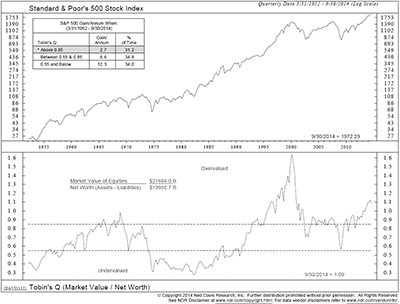Harry S. Dent Jr.'s Blog, page 161
March 11, 2015
Hold Tight! Nanotechnology Is Rapidly Changing Our Economy
Last Friday, I wrote to you about the Nasdaq reaching highs of old and warned that perhaps things aren’t all that different between today’s bubble and the bubble that obliterated so many investors back in the early 2000s.
Of course, this is contrary to what most analysts are saying right now. But that shouldn’t surprise you. As Pete DiOrio called me before I debated Peter Schiff at his St. Kitts conference, I’m a contrarian’s contrarian!
I focused particularly on the biotech sector, comparing it to the Nasdaq and asked the question: Will biotech stocks endure a smaller correction than the Nasdaq in the great reset ahead, or will it correct more given that it has outperformed by over 60% in the rally since early 2009?
The honest answer is, I don’t know yet. But biotech, like India and emerging markets, is something I’m watching keenly. In the long-term, there’s a lot of potential there, and here’s why…
Numerous emerging technologies are set to shape our future beyond what the PC, smart phone, Internet and broadband has done for us since the late 1980s. The four I’m most interested in are (in order of emergence):
Biotech.Robotics.3D printing.Nanotechnologies.What sets these particular emerging technologies apart in my mind is that they operate from the bottom-up. They embody the new network economy…
When you can create new medical cures down to the genes and cells, that’s bottom-up. It’s more targeted.
When you can create products from smaller and more local 3D printing factories, that’s bottom-up.
Nanotechnologies literally promise that you can create something from the energy in the air — that should result in much cleaner production and energy. That’s bottom-up.
Already our life expectancies are rising much faster than the 1.5 year average since the ’60s. In the next four decades, they could potentially rise even faster than the average four years we gained between the 1930s and 1960s. A recent cover of Time proclaimed that a baby born today could now live to be 142 years old. A cover on National Geographic last year told the same story. I think those claims are a little optimistic, but it is entirely possible that we achieve a 120-year life span in the next 40 to 50 years.
That is the one game changer we see for changing the dismal demographic outlook in developing countries in the decades ahead.
Again, we’re taking massive leaps forward in our ability to grow new organs, target cancers more precisely, change bad genes, clean out our arteries with nanobots, and even scrub the CO2 from our atmosphere.
Printing human organs is already a decade-old practice.
We will have increasingly intelligent robots to help us make products more cheaply in developed countries, putting us back in competition with emerging countries and their cheap labor.
Aging societies are moving inexorably towards a life filled with robots to care for the aged. Japan is leading the charge on this score.
Author of Sapiens, Yuval Noah Harari, even believes that thanks to our technological advancements, humanity will be unrecognizable by 2045. That is, how we are today will cease to exist and we will be something entirely new.
But the base of this next revolution, which my 45-Year Innovation Cycle shows will surge again from 2032 and mature around 2055, is biotech. It’s like the Internet of the future, but even it is still in in its infancy, like personal computers in the 1980s. And Ben Benoy has his finger on the pulse. (Or is it more accurate to say he has his finger on the human genome?)
Even better, he has found a way to use the revolutionary technology of today to play the revolutionary technology of tomorrow.
What strikes me as most powerful, however, is that his system doesn’t rely on the biotechnology sector moving up in a straight line. As I mentioned last Friday, this sector faces a rocky road ahead as we move across the 45-Year Innovation Cycle plateau between now and 2032. So the fact that Ben is able to play both sides of the market using his system makes it something you should consider adding to your investment strategies.

Harry
March 10, 2015
Caught Out! The Fed’s Dangerous Little White Lies
Speaking of things the Fed or government have absolutely nothing to do with, do you really believe either of them have much control over jobs growth, unemployment or even wages? Sorry, that was a leading question…
The point is, when all is going well in a growing economy — however many hundred thousand jobs we add a month, a low employment rate — our politicians and monetary officials take all the credit. (On a side note, never do they seem to take the blame.)
Sure, Congress does mandate the Fed to optimize their monetary policy for maximum employment, but neither one of them have very much to do with jobs.
Okay okay, lower interest rates, taxes and less regulation can make it easier to conduct business and vice-versa. But that doesn’t drive employment. Businesses drive employment.
Businesses employ people, and employment grows when business grows. Businesses grow when profitability increases. And profitability increases when business offers better products at better prices because sales grow. Sales make money. Money drives employment.
So let’s be clear: Corporate sales don’t grow because interest rates are artificially low. Companies may temporarily opt to buy back shares in a low interest-rate environment, but the ones who are adding jobs are re-investing in capital improvements and research and development.
So what is the Fed doing if not increasing jobs? As Rodney mentioned today, the Fed is giving an unfair advantage (by keeping interest rates artificially low) to borrowers and penalizing savers, while encouraging savers to spend even though wage growth is nearly non-existent.
But here’s the problem: If we’re increasing jobs, and wage growth is remaining stagnant… doesn’t that mean the quality of our jobs is getting worse and not better!? And to paint an even prettier picture, the percentage of our total labor force employed (participation rate) is as low now as it was back in the 1970’s!
So, if anyone were to ask me what I think of how the Fed is managing our economy I would say 1) I don’t think they ought to be trying to, and 2) they aren’t doing a very good job.
The next time I hear a politician take credit for economic growth or increasing jobs, my face may turn red and steam may start come out of my ears before I scream “get off of my lawn!” The success of any politician is not a reflection of their policies and how they have helped grow the economy, jobs or created a better standard of living for their constituents.
As Harry has shown through many years of research, that would be the result of a favorable demographic environment — one that allows businesses to grow, be profitable, hire more people and pay higher wages.

Lance
The Fed’s Self-Defeating Policies: Any Method Behind The Madness?
There’s always a list of things that answer the age-old question of “When?” You know you’re old when… or you know you’re a Yankee when… or (you knew it was coming) you know you’re a redneck when, etc.
Let’s add another list based on finance.
You know the world’s gone crazy when the government tries to force-feed inflation, consumers are encouraged to borrow, saving is frowned upon, and markets cheer bad news because it means the Fed is likely to hold interest rates negative for longer. It’s completely backwards!
As individuals we should save more, take on less debt, strive for low or even no inflation, and push for the Fed to stop meddling in the markets. Achieving these things would make each of us more financially secure and would preserve the spending power of the funds we’re able to save.
But while politicians and agency heads pay lip service to teaching Americans to provide for their own future, these same people spend their days desperately trying to engineer a return to the economy of 2004, when we spent everything, saved almost nothing, took on record amounts of debt, and paid little attention to the costs of the falling dollar. It’s a classic case of chasing short-term gain at the expense of long-term pain.
In this case, what’s good for the goose isn’t necessarily good for the gander. One man’s spending is, after all, another man’s income, so a lack of spending by some leads to lower income for others, including less employment in general.
Refusing to take on debt is the same thing as saving in a way, and has the same effect on the economy assuming that we take on debt in order to purchase things.
As for inflation, it helps borrowers by making debt payments more affordable because the debts are repaid with less valuable dollars. This is important since, even after their efforts to reduce their debt outstanding, Americans personally still owe trillions, and the federal government owes about a full year’s GDP at roughly $18 trillion.
Low interest rates also help borrowers. Anyone with a savings account, money market account, or CD knows that rates are near zero even though core inflation, while low, is running over 1.5%. This allows borrowers to take on debt that is nearly free of interest, since their cost of borrowing will be barely above the rate of inflation. The biggest beneficiary of this is the U.S. government because it has the largest amount of debt outstanding.
Unfortunately, higher inflation and low interest rates hurt savers.
Just as one man’s spending is another man’s income, one man’s savings is another man’s loan. Holding down the cost of such loans provides an unfair advantage to the borrower at the expense of the saver, who is denied his market rate of interest. Pushing up inflation will assist the borrower, but erodes the value of the payments received by the lender.
All of this is done in the name of reinvigorating the economy, even though it causes massive dislocations in the markets.
The problem is competing motivations. The government wants to see savers spend more, while the savers themselves have a different goal — accumulating enough wealth to carry them through retirement years.
The irony is that government and Fed policies are eventually self-defeating, because they discourage savers from spending even less than they already were. As long as interest rates remain low, savers must sock away even more cash in order to meet their investment goals.
Which brings us to the real demon that Fed governors and politicians are fighting. It isn’t a mindset on the part of consumers and savers. It’s the way demographic waves are washing through our economy.
The bulk of the boomers, the largest generation in our population, were born in the late 1950s and early 1960s. As this group moves through their peak saving years, from 50- to 65-years old, they are focused on paying down debt and putting away more resources for retirement — NOT spending more.
At the same time, the generation following them, Generation X, is much smaller and doesn’t have anywhere near the same spending power as the boomers. They can’t fill the consumption vacuum that the boomers left behind.
Short of guaranteeing everyone’s financial future so that they freely spend all of their assets today as well as borrow with abandon, there’s little the Fed, politicians, or anyone can do to change the way these forces work in our economy.
Circling back to the top: You know the world’s gone crazy when policy makers ask us to commit financial suicide, and are stunned when we refuse.

Rodney
P.S. So if the Fed can’t do anything about the way our economy is heading, what exactly are they doing? Lance explores this question in today’s Ahead of the Curve. Keep reading…
Caught Out! The Fed’s Dangerous Little White Lies
Speaking of things the Fed or government have absolutely nothing to do with, do you really believe either of them have much control over jobs growth, unemployment or even wages? Sorry, that was a leading question…
The point is, when all is going well in a growing economy — however many hundred thousand jobs we add a month, a low employment rate — our politicians and monetary officials take all the credit. (On a side note, never do they seem to take the blame.)
Sure, Congress does mandate the Fed to optimize their monetary policy for maximum employment, but neither one of them have very much to do with jobs.
Okay okay, lower interest rates, taxes and less regulation can make it easier to conduct business and vice-versa. But that doesn’t drive employment. Businesses drive employment.
Businesses employ people, and employment grows when business grows. Businesses grow when profitability increases. And profitability increases when business offers better products at better prices because sales grow. Sales make money. Money drives employment.
So let’s be clear: Corporate sales don’t grow because interest rates are artificially low. Companies may temporarily opt to buy back shares in a low interest-rate environment, but the ones who are adding jobs are re-investing in capital improvements and research and development.
So what is the Fed doing if not increasing jobs? As Rodney mentioned here, the Fed is giving an unfair advantage (by keeping interest rates artificially low) to borrowers and penalizing savers, while encouraging savers to spend even though wage growth is nearly non-existent.
But here’s the problem: If we’re increasing jobs, and wage growth is remaining stagnant… doesn’t that mean the quality of our jobs is getting worse and not better!? And to paint an even prettier picture, the percentage of our total labor force employed (participation rate) is as low now as it was back in the 1970’s!
So, if anyone were to ask me what I think of how the Fed is managing our economy I would say 1) I don’t think they ought to be trying to, and 2) they aren’t doing a very good job.
The next time I hear a politician taking credit for economic growth or increasing jobs, my face may turn red and steam may start come out of my ears before I scream “get off of my lawn!” The success of any politician is not a reflection of their policies and how they have helped grow the economy, jobs or created a better standard of living for their constituents.
As Harry has shown through many years of research, that would be the result of a favorable demographic environment — one that allows businesses to grow, be profitable, hire more people and pay higher wages.

Lance
The Fed’s Self-Defeating Policies: Any Method Behind The Madness?
There’s always a list of things that answer the age-old question of “When?” You know you’re old when… or you know you’re a Yankee when… or (you knew it was coming) you know you’re a redneck when, etc.
Let’s add another list based on finance.
You know the world’s gone crazy when the government tries to force-feed inflation, consumers are encouraged to borrow, saving is frowned upon, and markets cheer bad news because it means the Fed is likely to hold interest rates negative for longer. It’s completely backwards!
As individuals we should save more, take on less debt, strive for low or even no inflation, and push for the Fed to stop meddling in the markets. Achieving these things would make each of us more financially secure and would preserve the spending power of the funds we’re able to save.
But while politicians and agency heads pay lip service to teaching Americans to provide for their own future, these same people spend their days desperately trying to engineer a return to the economy of 2004, when we spent everything, saved almost nothing, took on record amounts of debt, and paid little attention to the costs of the falling dollar. It’s a classic case of chasing short-term gain at the expense of long-term pain.
In this case, what’s good for the goose isn’t necessarily good for the gander. One man’s spending is, after all, another man’s income, so a lack of spending by some leads to lower income for others, including less employment in general.
Refusing to take on debt is the same thing as saving in a way, and has the same effect on the economy assuming that we take on debt in order to purchase things.
As for inflation, it helps borrowers by making debt payments more affordable because the debts are repaid with less valuable dollars. This is important since, even after their efforts to reduce their debt outstanding, Americans personally still owe trillions, and the federal government owes about a full year’s GDP at roughly $18 trillion.
Low interest rates also help borrowers. Anyone with a savings account, money market account, or CD knows that rates are near zero even though core inflation, while low, is running over 1.5%. This allows borrowers to take on debt that is nearly free of interest, since their cost of borrowing will be barely above the rate of inflation. The biggest beneficiary of this is the U.S. government because it has the largest amount of debt outstanding.
Unfortunately, higher inflation and low interest rates hurt savers.
Just as one man’s spending is another man’s income, one man’s savings is another man’s loan. Holding down the cost of such loans provides an unfair advantage to the borrower at the expense of the saver, who is denied his market rate of interest. Pushing up inflation will assist the borrower, but erodes the value of the payments received by the lender.
All of this is done in the name of reinvigorating the economy, even though it causes massive dislocations in the markets.
The problem is competing motivations. The government wants to see savers spend more, while the savers themselves have a different goal — accumulating enough wealth to carry them through retirement years.
The irony is that government and Fed policies are eventually self-defeating, because they discourage savers from spending even less than they already were. As long as interest rates remain low, savers must sock away even more cash in order to meet their investment goals.”
Which brings us to the real demon that Fed governors and politicians are fighting. It isn’t a mindset on the part of consumers and savers. It’s the way demographic waves are washing through our economy.
The bulk of the boomers, the largest generation in our population, were born in the late 1950s and early 1960s. As this group moves through their peak saving years, from 50- to 65-years old, they are focused on paying down debt and putting away more resources for retirement — NOT spending more.
At the same time, the generation following them, Generation X, is much smaller and doesn’t have anywhere near the same spending power as the boomers. They can’t fill the consumption vacuum that the boomers left behind.
Short of guaranteeing everyone’s financial future so that they freely spend all of their assets today as well as borrow with abandon, there’s little the Fed, politicians, or anyone can do to change the way these forces work in our economy.
Circling back to the top: You know the world’s gone crazy when policy makers ask us to commit financial suicide, and are stunned when we refuse.

Rodney
P.S. So if the Fed can’t do anything about the way our economy is running, what exactly are they doing? Lance explores this question in today’s Ahead of the Curve. Keep reading…
March 9, 2015
“You Are Entitled to Nothing” – Frank Underwood Is Bang on the Money
He may be a murderous bastard with no conscience, but if Frank Underwood were a real-life candidate for the presidency, I would vote for him.
Frank is not a real person, of course. He’s the crooked politician Kevin Spacey portrays in the Netflix series House of Cards who claws his way into the White House by manipulating the press and ruthlessly crushing anyone that might get in his way. But sadly, with one line, he delivered more honesty than I have seen from any president, senator or House representative, from either party, in my lifetime:
“We’ve been crippled by Social Security. By Medicare. Medicaid. Welfare. And entitlements. And that is the root of the problem. Entitlements. Let me be clear: You are entitled to nothing.”
Damn straight!
Social Security and Medicare are not “rights” in any sort of legal sense. Congress decides on the payout, and Congress can change it — or eliminate it — at any time. You really are not “entitled” to anything, and certainly not guaranteed.
But that’s not the message we get from our leaders. They’ll tell us whatever they need to get re-elected.
And while it’s not fun to hear, it’s important to keep it in mind when planning for retirement. Always move forward with the assumption that your benefits in retirement will be lower than currently promised … possibly much lower.
So here are some specific recommendations on how to approach your planning:
Focus on income rather that the “magic number.” Most financial planning centers around amassing a nest egg of a certain size, but this is completely backwards as it doesn’t take market yields into account. A million-dollar bond portfolio that would have paid $40,000 ten years ago would only pay about $22,000 today.Consider investments you might not have considered before, like preferred stock and closed-end bond funds. With the stock market priced to deliver lousy returns over the next decade — and yielding a pitiful 1.8% in dividends — these investments can deliver solid income if bought at a good price.While I’ve never been a fan of variable annuities due to their high fees and maddening complexity, an immediate annuity, like a pension, can be a great way to receive a steady stream of income.Use market volatility to your advantage. There are sectors of the stock market that fluctuate so wildly that you have the opportunity to make tremendous gains in a very short amount of time. Of course, the risks here are obvious, which is why you should piggy-back off someone who knows what they’re doing.Don’t assume you’ll have jerry-rigged government programs to fall back on. Assume you’re entitled to nothing, and set about planning accordingly.

Charles
Quantitative Easing: Be Afraid, Be Very Afraid…
The major concern since the Fed and central banks around the world began printing unprecedented amounts of money has been inflation.
Naturally, we disagreed. We’ve been calling for low inflation and ultimately deflation since this craziness began. We also warned that no good would ultimately come of these activities. And so far, anyone that isn’t blind can see the dangers building! Today we have an even greater debt and financial bubble and it will burst, sooner rather than later.
All central banks have done is pervert the economy and the markets. The result has been greater speculation and greater bubbles. There will be a collapse more dramatic than what we saw in 2008 and 2009.
Thanks for nothing Bernanke, Yellen and company!
What could these people have been thinking?
Clearly, they were thinking more about the rich than the middle-class or poor as all unprecedented QE has done is drive up financial asset prices, not help the everyday household. Such money printing has been largely to save financial institutions that used increasingly cheap Fed-driven money to speculate in everything from risky loans to stocks to commodities to real estate to complex and very dangerous derivatives.
Now they are just doing that more than ever.
When the whole financial system was melting down (as in the early 1930s) the response was: We will save the banks and financial institutions at all costs. The Fed is, after all, not a public institution. It is owned by the banks.
But why do that? If they melt down, we can finally be rid of excess leverage and fat in the system. How can we expect banks to make good decisions in the future if they don’t fail when they make the riskiest loans in history? We could finally get into a position from which to grow again if we just exhaled and let these debt and financial bubbles burst. We’d have another great depression! And that’s exactly what they don’t want.
Pity for them, that’s what we’re going to get anyway… just ahead.
What central bankers seem to fail to understand is that you don’t get something for nothing. Surviving and growing takes constant effort, innovation and investment in the future… all of which is exactly the opposite of what we naturally strive for. We want to win the lottery; we want peace, not pain. We really do want something for nothing and we’ll go to great lengths to get it (even if, ultimately, we’re unsuccessful).
That’s what makes marketing and sales pitches so effective. They promise us great gains and results with little or no effort.
Guess what? We’ve just been sold the greatest something-for-nothing pitch in history: Quantitative Easing. And now we’re all going to pay the price: especially the ultra-rich and the financial institutions they’ve been supporting the most.
David Stockman couldn’t agree more. In fact, we delved into this topic in some detail – and explored what outcomes are most likely ahead ‑ recently in a spirited interview. Take a few minutes to watch it here.

Harry
P.S. Charles has a few choice words of his own regarding backwards governmental programs in today’s Ahead of the Curve, as well as some good recommendations on how to position yourself financially. Check it out here…
March 6, 2015
The Race Is On: Biotech Beats Moore’s Law!
In 1965, one of the co-founder’s of Intel Corporation, Gordon E. Moore, wrote an article in Electronics Magazine on a trend he had been watching for several years in integrated circuit (chip) manufacturing.
Gordon observed that over the course of 18 months, the performance of computer chips manufactured had doubled in capability. This phenomenon would later go on to be labeled “Moore’s Law” and has been a cornerstone for long-term planning within the semi-conductor industry since the 1960’s.
Now we can all attest to buying a new computer or smart phone, only to have something smaller, faster, and lighter come out in what seems like only days after your purchase. But taking into consideration an 18-month cycle time on doubling of performance, how could this be?
What I’m about to say may fly in the face of reason but bear with me… recent breakthroughs in manufacturing technology and advanced computing have begun to surpass Moore’s Law.
What’s more is that it’s expected to be fully surpassed across the industry between 2015 and 2020 by constructing transistors at the atomic level. That’s right!
In 2012, a research team from the University of New South Wales developed the first working transistor consisting of a single atom placed precisely on a silicon crystal. Now it’s only a matter of time until production capability will ramp up across the industry because of this amazing breakthrough.
Many in biotech are starting to treat this breakthrough as an “enabling technology” for the industry as a whole. Attacking hard problems such as sequencing a human genome for custom precision medicine. Ten years ago, it would have taken months to sequence a single genome, now this can be done in less than an hour.
IndieBio is a biotech startup company accelerator and they’re taking advantage of this new wave of technology by speeding up the business process of bringing newly enabled biotech solutions to market.
Ron Shigeta, the chief scientific officer of IndieBio recently stated: “What a lot of people seemed to have missed is that the pace of innovation in life sciences is accelerating, sequencing technologies alone are exceeding the pace of Moore’s law.”
Make no mistake, we are entering unchartered territory with these serious groundbreaking biotech innovations… all of which should make noticeable differences in how we live our lives over the next several years.
If you’re interested in learning more about game changing biotechnology and take advantage of market plays check out my Biotech Intel Trader service here.
As always, I’ll continue to monitor the market’s latest health and biotech technology trends via my social media collective intelligence tool and keep you updated on the latest.

Ben
Biotech: From Dot-Com Bubble to Dot-Com Bust!
The Nasdaq bubble from late 1994 to early 2000 was the greatest bubble in modern U.S. history. AOL got to a price/earnings ratio (P/E) of 400 at the top! The problem was that a large company like that could never have grown enough to fulfill such expectations.
But that’s the thing with bubbles… how they inflate to such extremes: They’re irrational.
A new sector comes along, demonstrates higher than average growth rates and before you know it fundamentals are out the window and the stupid money is chasing the market up.
You know how that ends: From dot-com bubble to dot-com bust.
Of course, nowadays, everyone’s thinking about that infamous bubble again because the Nasdaq is back at the highs it once enjoyed into early 2000. And analysts are banding about the most idiotic statement ever uttered in the history of humanity: “This time is different!”
If I hear another person say that, I may just hit them!
OK… technically, this time IS different. Back into 2000, it was the Internet that lead the charge to Nasdaq highs. Today those highs have stalwarts like Google and Apple and new leaders from social media — I’m talking about companies like Facebook and Twitter — to thank. But overall the tech sector is much more mature than it was 15 years ago. The great Internet Revolution now permeates every household, every store and almost every nook and cranny possible (with a few exceptions).
So I’ll give you that: it’s different on the surface, but is it really all that different?
Social media companies are now massive corporations that control their respective spaces — Facebook rules the social universe — but aren’t they just as big nowadays as the AOLs of yesteryear?
Really, how much more can they grow… and how fast?
And what do they really offer? What do the social media companies do to improve productivity? It’s a way people can express themselves and have a little fun. But if anything, I’d say they hurt productivity! No company wants their employees goofing off on Facebook half the day. Really, their offerings are a bit nebulous.
This, for me, is a whopper of a red flag!
I have incorporated a 45-year Innovation Cycle into my hierarchy of cycles because it has proved highly accurate and reliable. It shows how clusters of powerful technologies increase productivity and move mainstream for about 22.5 years, like what we saw from 1988 into 2010.
Now we’re in the doldrums of this cycle and won’t move into the next upward swing again until after 2032. In short, the productivity revolution is over for the next two decades or so. That means less earnings and wage gains, regardless of demographic trends.
So this dot-com boom 2.0 concerns me…
We have these “too big to fail” companies that have a negative impact on productivity (mostly) and no tangible offering to really sink your teeth into (think about it… what does Facebook really offer? How about Alibaba?), and boatloads of investors scrambling to get in on the action. Talk about irrational!
It seems to me like yet another reason to get ready for a massive correction later this year and into 2016.
Rather than trying to jump onto a train that really doesn’t have much further to go, look to climb on board one that’s only now pulling out of the station.
I’m talking about biotech. It is still in its infancy; the 0% — 10% stage of its longer term S-Curve but there is infinitely more potential for investments in this developing revolution than there are in today’s more mature technology sector. That’s why it is a sector of great interest to me. And why I think Ben Benoy is fishing in the right pond…
But there’s something else I think Ben’s doing right: He’s not exclusively betting that the biotech market can only go up. Instead, he has developed a unique system that allows him to play the ups and downs with ease. He will be explaining how he does this on Monday, and I think you should watch, particularly because I think this sector faces some rough seas ahead.
It shows you how biotech outperformed the 1995 to early 2000 tech bubble by 31%. More importantly, look how it’s outperformed the current bubble — by 65%!
Yet, in longer term charts, even though the biotech index has seen massively higher highs recently, it looks like that it is merely in a third-wave, with a major fifth-wave much higher in the decades ahead (near the top of the next bull market around 2036).
The question is: Does the Biotech index take a smaller correction than the Nasdaq in the great reset ahead, or does it correct more? After all, it has been volatile on the upswing since late 1994 and especially since early 2009.
I don’t know yet… but this, like India and emerging markets is a longer term picture my team and I are scouring for opportunities.
And guys like Ben are mastering ways to profit from this promising sector NOW. Do yourself a favor: be on that list to watch Ben’s video on Monday.

Harry
March 5, 2015
Risk Management for Investors: Be on High Alert
I’ve recently written about the market residing in heady territory due to rich valuations and overly optimistic sentiment despite a significant drop in forward earnings estimates. Another valuation metric is sounding warning bells that the market is not only overvalued, but is trading at a level rarely seen, even in bubbles. That metric is the Tobin’s Q.
Tobin’s Q was developed by Yale University economist, James Tobin. The Q ratio is found by taking the market value of assets and dividing them by the replacement value of those assets. The gist is that assets will be purchased in the marketplace as long as it’s cheaper than developing those assets from scratch.
And that makes perfect sense.
Tobin’s Q can fluctuate wildly from being seriously undervalued all the way to nosebleed overvaluations. The current ratio of 1.09 is not only overvalued, but the second highest in at least 62 years with the exception of the run-up in the late 1990s.
If we look back historically, we see plenty of opportunities to aggressively add to equities. Replacement value was incredibly cheap in the early 1950s before a huge run in equities that took the market to new highs.
Then, after a nasty bear market in the early to mid-1970s, the Q ratio reached fire sale levels for a few years. While it took a while, it set up the massive secular bull market that started in 1982.
Bubbles that were popped preceded the substantial market gains. But, those bubble periods didn’t experience the levels we see today. Is the current valuation a call for a run for the exits?
Maybe not.
After all, Tobin’s Q reached stratospheric highs in 2000 as the Internet bubble peaked.
However, it is a call to manage risk. In my opinion, investors are pretty terrible at managing risk. Why throw money at the market now with reckless abandon when many indicators such as sentiment, earnings estimates, valuations on earnings and revenues, as well as the replacement value of assets is telling you that future returns are likely to be very low until we clear out some of the speculative excess that exists in the market?
Everyone needs better insight and as such, we need to really look at all of these indicators… just as Ben Benoy does for our Dent Research team. He analyzes sentiment in a very different way and you may just want to take a look at it in a series of free videos currently being offered detailing a peek under the hood. It’ll give you a new perspective on an old concept — making money. You can get more information here.
That said… now is the time to be on high alert. Tighten stops. Allocate new capital cautiously. And, prepare for the better opportunities that lie ahead when everyone else finally runs for the exits all at once.

John





